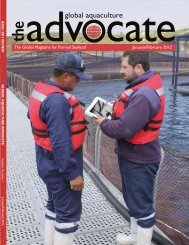May/June 2010 - Global Aquaculture Alliance
May/June 2010 - Global Aquaculture Alliance
May/June 2010 - Global Aquaculture Alliance
Create successful ePaper yourself
Turn your PDF publications into a flip-book with our unique Google optimized e-Paper software.
Norwegian, U.K. Salmon Fillets Jump<br />
As Chile Recovers From Earthquake<br />
Although lower than in January 2009, import levels<br />
of salmon fillets rose at the start of <strong>2010</strong>.<br />
January year-to-date (YTD) imports of salmon to the U.S.<br />
began 7.3% lower than year-ago levels (Table 2). Frozen whole<br />
fish imports continued to see YTD increases and were 36.0%<br />
higher YTD than in January 2009. Fresh whole fish also experienced<br />
an increase of 6.7%. Fresh fillets and frozen salmon fillets,<br />
on the other hand, began <strong>2010</strong> 24.5% and 5.1% lower, respectively,<br />
than 2009 YTD levels. Total month-to-month data<br />
showed a 3.8% increase.<br />
Whole Fish<br />
YTD figures for fresh whole fish showed beginning-of-theyear<br />
increases 6.7% over January 2009 YTD. Month-to-month<br />
data for December 2009 to January also showed an increase, up<br />
3.9%. Salmon imports from Canada began <strong>2010</strong> 6.3% lower<br />
YTD. Month-to-month imports, however, increased 10.3%<br />
from December 2009 to January.<br />
Pricing in the Northeast was full steady to firm throughout<br />
the month of March in the heart of Lent. Supplies were ade-<br />
Form<br />
Fresh whole fish<br />
Frozen whole fish<br />
Fresh fillets<br />
Frozen fillets<br />
Total<br />
January <strong>2010</strong><br />
(lb)<br />
18,040,493<br />
416,329<br />
12,307,019<br />
12,360,249<br />
43,124,090<br />
Sources: U.S. Census, Urner Barry Publications, Inc.<br />
quate for a moderate to active demand. All sizes continued well<br />
above the three-year averages.<br />
The West Coast whole fish market, similar to the Northeast,<br />
was full steady to firm for the month of March. Supplies ranged<br />
adequate to barely adequate for a moderate to active demand.<br />
Pricing for West Coast fish also continued the year trending well<br />
above the three-year average for all sizes of fish.<br />
Fillets<br />
Salmon imports to the U.S. began <strong>2010</strong> with Norway leading<br />
as the top source for fresh fillets. During January, 4.9 million lbs<br />
were imported from Norway, while Chile sent 4.3 million lbs.<br />
Overall, January YTD levels were 23.3% lower than year-ago<br />
levels. On the other hand, import volume rose 8.9% since<br />
December 2009.<br />
Norwegian fillets began <strong>2010</strong> 669.1% higher than last year at<br />
the same time. Chilean fillets, in contrast, were 68.9% lower<br />
than 2009 YTD figures. Canada and the United Kingdom also<br />
started <strong>2010</strong> with strong exports to the U.S. at 85.9% and<br />
317.4% higher than YTD levels, respectively. Each sent over 1<br />
million lbs in January.<br />
Month-to-month data for Norway was up 24.6% from<br />
December 2009, while Chile showed a decrease of 6.0% for the<br />
same time period.<br />
The Norwegian fillet market firmed at the beginning of<br />
March and remained steady for most of the month. At the<br />
beginning of March, the country of Chile experienced a massive<br />
earthquake that affected transportation and logistics in the country.<br />
Salmon exports resumed fairly quickly, though, and pricing<br />
trended higher. Current pricing for the Chilean fillet market is<br />
about steady. The undertone is somewhat unsettled with both<br />
higher and lower offerings noted.<br />
Table 2. Snapshot of U.S. salmon imports, January <strong>2010</strong>.<br />
December 2009<br />
(lb)<br />
17,369,542<br />
839,814<br />
11,405,146<br />
11,942,936<br />
41,557,438<br />
Change<br />
(Month)<br />
3.9%<br />
-50.4%<br />
7.9%<br />
3.5%<br />
3.8%<br />
January <strong>2010</strong><br />
(lb)<br />
16,906,368<br />
306,191<br />
16,308,602<br />
13,018,728<br />
46,539,889<br />
Change<br />
(Year)<br />
6.7%<br />
36.0%<br />
-24.5%<br />
-5.1%<br />
-7.3%<br />
YTD <strong>2010</strong><br />
(lb)<br />
18,040,493<br />
416,329<br />
12,307,019<br />
12,360,249<br />
43,124,090<br />
Fresh Tilapia Fillet Prices Spike After Lent,<br />
Frozen Imports Set Monthly Record<br />
In January, total tilapia imports to the U.S. increased when<br />
compared to the previous month (Table 3). Fresh fillets registered<br />
a more than modest increase, while frozen fillets recorded a<br />
monthly record high. Imports of whole fish also increased during<br />
the first month of <strong>2010</strong>.<br />
Whole Fish<br />
Although imports of whole tilapia increased when compared<br />
to the previous month, January imports decreased when com-<br />
YTD 2009<br />
(lb)<br />
16,906,368<br />
306,191<br />
16,308,602<br />
13,018,728<br />
45,539,889<br />
Change<br />
(Year)<br />
6.7%<br />
36.0%<br />
-24.5%<br />
-5.1%<br />
-7.3%<br />
pared to the same month in previous years. This is relevant, as<br />
this month has historically shown a large influx of product as<br />
importers prepare inventories for Lent.<br />
Fresh Fillets<br />
January imports of fresh fillets increased when compared to<br />
the previous month as well as surpassing the monthly average for<br />
2009. However, when compared to the same month in previous<br />
years, January marked the lowest level of imports since 2006.<br />
January imports of fresh fillets surpassed the monthly average<br />
for 2009, but when compared to the same month in previous<br />
years, marked the lowest level since 2006.<br />
Due to falling prices and diminished margins in the past couple<br />
of months, volumes have been adjusting lower as supply and<br />
demand find a balance in the market. That said, prices started<br />
adjusting slightly higher prior to the beginning of Lent, as<br />
Sources: U.S. Census, Urner Barry Publications, Inc.<br />
demand was noted stronger.<br />
However, a sudden shortfall of product in the U.S. caused<br />
prices to spike rapidly during the weeks after Lent started. Availability<br />
has improved somewhat, easing some of the upward pricing<br />
pressure. The market is currently rated full steady to steady.<br />
Frozen Fillets<br />
Imports of frozen tilapia fillets surpassed the 31 million lbs<br />
mark in January, registering a monthly record. Inventories in the<br />
U.S. were more than adequate amid a soft demand. After the<br />
Chinese year-end festivities ended, replacement costs started to<br />
rise, making some importers raise their asking prices. As a result,<br />
the market in the U.S. firmed slightly, but not to the extent<br />
replacement offerings did. The current undertone is steady at<br />
listed levels.<br />
The fresh market is showing some signs of recovery after a<br />
sudden shortage of product, but the pricing undertone remains full<br />
steady to steady. The frozen market, on the other hand, is steady<br />
at listed levels. But many traders expect higher prices in the<br />
upcoming weeks as replacement offerings have gone up more than<br />
asking prices in the U.S., mainly due to adequate inventories.<br />
70 <strong>May</strong>/<strong>June</strong> <strong>2010</strong> global aquaculture advocate global aquaculture advocate <strong>May</strong>/<strong>June</strong> <strong>2010</strong> 71<br />
Form<br />
Frozen whole fish<br />
Fresh fillets<br />
Frozen fillets<br />
Total<br />
GOAL<br />
<strong>2010</strong><br />
January <strong>2010</strong><br />
(lb)<br />
7,407,378<br />
4,691,395<br />
31,004,989<br />
43,103,762<br />
December 2009<br />
(lb)<br />
7,047,451<br />
4,298,379<br />
30,102,848<br />
41,448,678<br />
October <strong>2010</strong> –<br />
Kuala Lumpur, Malaysia<br />
Change<br />
(Month)<br />
5.11%<br />
9.14%<br />
3.00%<br />
3.99%<br />
Plan Now To Attend<br />
Network with aquaculture production and market<br />
leaders, and examine issues and solutions at GOAL <strong>2010</strong>.<br />
Kuala Lumpur offers a casual tropical atmosphere with<br />
easy access and affordable accommodations.<br />
Additional information will follow with invitations to GAA<br />
members and past GOAL participants.<br />
Co-hosted by the Malaysia Department of Fisheries<br />
Table 3. Snapshot of U.S. tilapia imports, January <strong>2010</strong>.<br />
®<br />
global aquaculture<br />
January <strong>2010</strong><br />
(lb)<br />
9,261,653<br />
5,014,463<br />
29,465,689<br />
43,741,805<br />
Change<br />
(Year)<br />
-20.02%<br />
-6.44%<br />
5.22%<br />
-1.46%<br />
Make<br />
Smarter<br />
Choices.<br />
Every Day.<br />
Market Prices,<br />
News and<br />
Analysis<br />
for the<br />
Food Industry<br />
YTD <strong>2010</strong><br />
(lb)<br />
7,407,378<br />
4,691,395<br />
31,004,989<br />
43,103,762<br />
Call 800.932.0617<br />
for a FREE trial<br />
YTD 2009<br />
(lb)<br />
9,261,653<br />
5,014,463<br />
29,465,689<br />
43,741,805<br />
www.urnerbarry.com<br />
Change<br />
(Year)<br />
-20.02%<br />
-6.44%<br />
5.22%<br />
-1.46%





